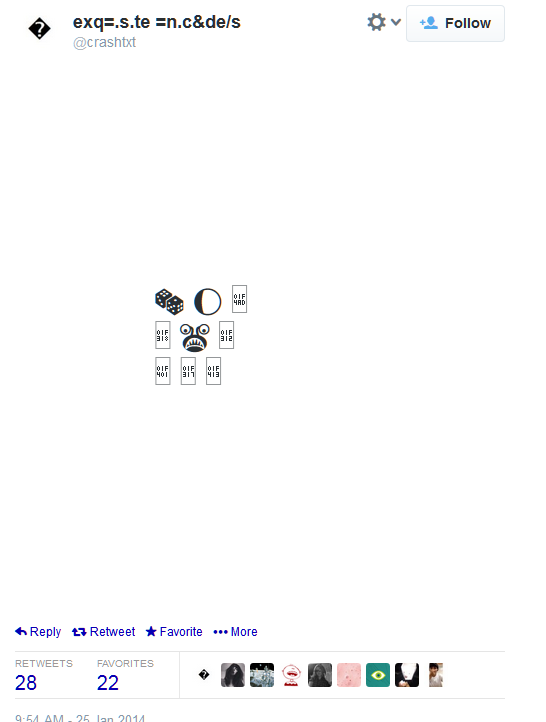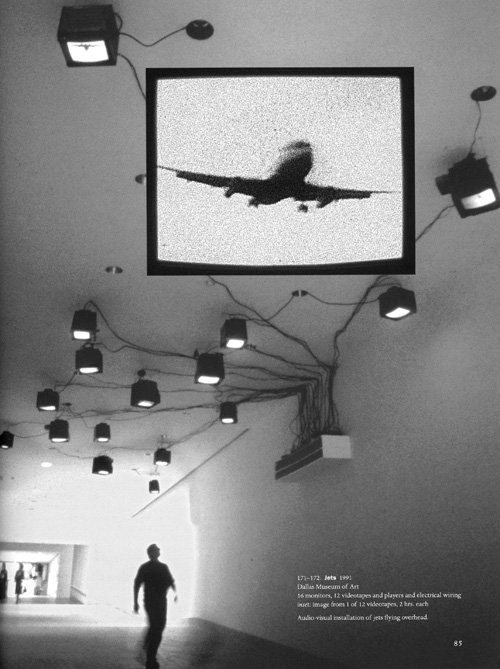Rene Abythe made a video, reposted here (6 MB .mp4), depicting the OptiDisc gif as a portal to time and space, which you can have on the dashboard of your car, along with your connections to Twitter and Facebook. In states where it's illegal to text while driving, you can journey into a wormhole to other universes. At least, your mind can, as your body flies through the windshield and your car mows down innocent pedestrians. No different than what would happen, really, if you were checking your friends' statuses at 60 per.
January 2014
crashtxt

crashtxt, the twitter account, appears to be mostly the net art legend, jimpunk, but I haven't determined yet how much it's him, how much it's interactive, and what the relationship is between it and his other twitter account, llllll__lllllll
Short review: creative, fairly relentless use of unicode icons as a kind of latter-day ASCII art, veering between chaotic expressionism and tight renderings of cool skulls. On the hacking vs defaults continuum it comes closer to "Being and critiquing The People by using the tools made by The Man" than "Empowering The People by subverting The Man's power." Mostly it's jimpunk being jimpunk, but we're supposed to say it's all about the mix and avoid any suggestion that his art might be, gasp, gag, hermetic.
An article in the gaming journal Kill Screen didn't help much at all: the author started out with the fusty dichotomy of art-in-museums-you-aren't-supposed-to-touch vs wacky contemporary art where YOU are also the artist. She also uses the late '90s term net.art throughout. And apparently never doped out why jimpunk wasn't replying to her emails in complete English sentences similar to her own.
Unlike ASCII, which can be made on a typewriter, unicode depends on how well your operating system, browser, and or appliance can read it, so you may see a lot of posts like this one:

crashtxt also features screenshots of unicode arrangements, as well as screenshots of glitched versions of this and that. The twitpic at the top of this post is a screenshot saved directly from the site -- no idea how it's done or what the back story is, but it's an exquisite, or perhaps exq=.s.te image (despite being fuzzed out).
Addendum: As long as we're name-checking ASCII, let's also mention as precedent, the venerable, annoying "wingdings" or "webdings." On the crashtxt readability issue, here's a screenshot from Jules Laplace, who evidently can't see the unicode at all.
if you had more SID GUTS you'd do it again
Discussion on the Muff Wiggler modular synth nerd forum (multi-page / single page) of the SID GUTS module for Eurorack, which incorporates a vintage SID (sound interface) chip from an old Commodore 64 computer. The module is designed to port that characteristic lo-fi SID sound into the analog hardware environment and sounds great, but cuts off much of the functionality of the chip if you have the Commodore (and a tracker program, as Nullsleep notes on the forum) or an Elektron Sidstation synth (an amazing device, although Not Truly Hardcore in that a savant in Sweden did much of the programming for you).
The SID chip has 3 oscillators, each of which generates a variety of waveforms. In the Sidstation, and presumably trackers, these can be programmed as wavetable synths, giving rise to the familiar, still very desirable, arpeggiated arcade sound.* SID GUTS uses one oscillator as its main voice, a second oscillator to modulate (only) the triangle wave of the first voice, and ditches the third oscillator. You could buy 3 SID GUTSes to get a chord (as one Wiggler pointed out), but you still wouldn't have access to the wavetables. You can do a few interesting things with control voltage inputs to tweak the SID GUTS' sound, such as using an LFO to toggle back and forth between ring-modulation and "sync" mode, or to switch between waveforms in real time. And of course you're getting the SID chip's analog filter, which some Wigglers think is divine and others a throwaway.
The biggest drawback to the SID GUTS (which possibly had a limited run and may not even be available at this point) is that, unlike the Sidstation, the module doesn't come with a SID chip! The guts, if you will. You have to fish one out of an old Commodore or shop on eBay. There were a few different versions of SID chips made, and again, the Wigglers are divided on which is best. So you could spend $400 for the SID GUTS and still find a bum chip and not get the best use of the thing.
*A "long-time SID programmer" on the forum asserts that the SID chip "these days... can produce extremely sophisticated sounds, you would not believe (way beyond than these blip-blops). Even, there are more ways to trigger a voice and all sounds different (hard restart alone is an important sid-sensation factor). Wave-scanning-tables are also super important."
around the internet
Contemporary Art Daily's semi-official documentation of Michelle Grabner's show at MOCA Cleveland [hat tip schwarz] has, among other items of interest, a streaming version of her video as a member of CAR, Dale Chihuly Glass Camp for Boys (scroll about halfway down), 2002, which I saw in her then-gallery in NYC and had been looking for reappearances of.
One of the highlights of the Joanne McNeill editorial era at Rhizome.org was this Jack Womack interview.
Have been reading Womack's books and highly recommend them. Most were written in the late '80s/early '90s, when parts of Manhattan were still grungy, so by the dot com era the books' visions of militarily cordoned-off neighborhoods seemed somewhat off the mark. Manhattan has only gotten more fabulous, and Womack didn't foresee the Internet as mass soporific keeping the plebes down, but the books' essential truths about who is really running things have only grown more stark in our present era of "inverted totalitarianism," as political philosopher Sheldon Wolin terms it. Every day in every way, to paraphrase a fellow Womack reader, it's becoming a Dryco world.
from the vault: The Art Guys, Jets
A review I wrote for Art Papers when I lived in Texas, never submitted, then reworked for my blog in 2007. When I blogged I thought I didn't have a photo but belatedly realized it was in their 1995 catalog from the Contemporary Arts Museum, Houston, The Art Guys Think Twice. So here is the review again, with the photo I never had from the Dallas Museum, where I viewed the installation in '91 (the inset photo is as it appears in the book, to show what's otherwise difficult to see on the video monitors).

Jets, by The Art Guys
Dallas Museum of Art, November-December 1991The main concourse of the Dallas Museum of Art ascends in a series of broad, gently sloping ramps, creating spaces reminiscent of airport architecture. Appropriately, that's where the Art Guys placed their installation Jets during the 1991 Dallas Video Festival.
Sixteen TV monitors fanned across the ceiling over the ramps, linked by black cables to a neat bank of VCRs on the wall. Each monitor faced down with its back securely bolted to the ceiling--or so we hoped. The screens glowed pale blue, green, or violet, the ambient colors of footage taped from the sky at different times and places, and intermittently roared to life as an airplane passed across the screen.
The artists phased the tapes so at a given time some screens showed empty sky and others tracked commercial aircraft landing or taking off in wobbly, hand held fields of view. The random distribution of the zooming images along the corridor kept the viewer off guard: as you followed the progress of one jet, another would loom unexpectedly behind you.
The network of cables crawling across the ceiling and down the wall to a controlling ganglion could emblematize the global transportation and communication systems on which we are so dependent, while the fragility of the systems could be felt in the nervous-making Damoclean placement of the monitors. That's one level of interpretation.
Yet sitting beneath them for a few minutes revealed something a hurried passerby might have missed: their curious kinship to natural phenomena. The random lightening and darkening of screens and the antiphonal whining of the jets became paradoxically calming, like stars blinking or insects chittering in the breeze. Thus do our daily threats become reassuring background texture.
Have written about the Art Guys (Michael Galbreth and Jack Massing) a number of times (recently here).
